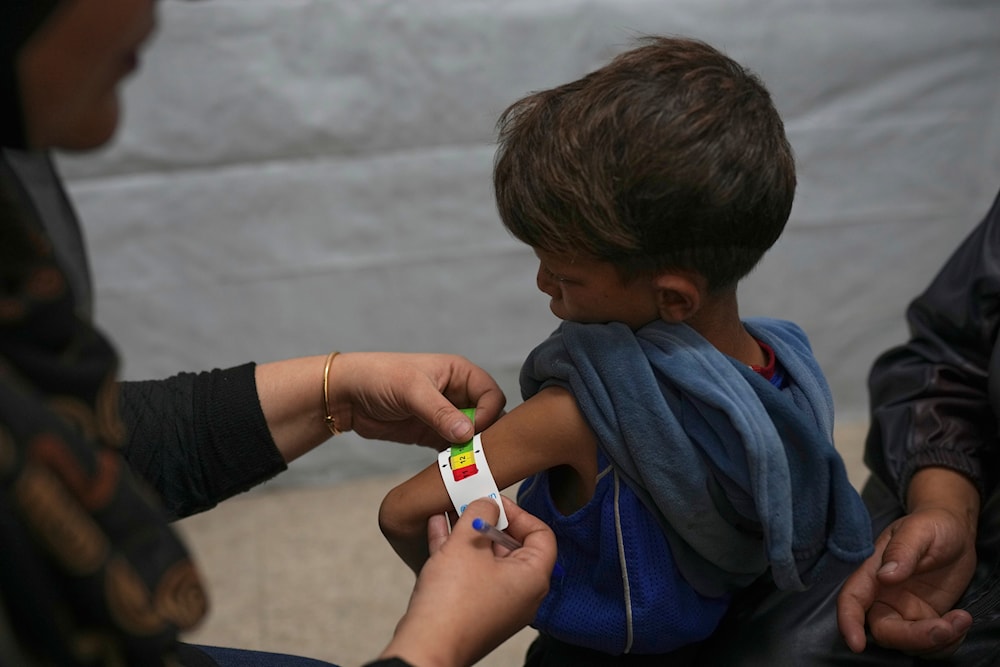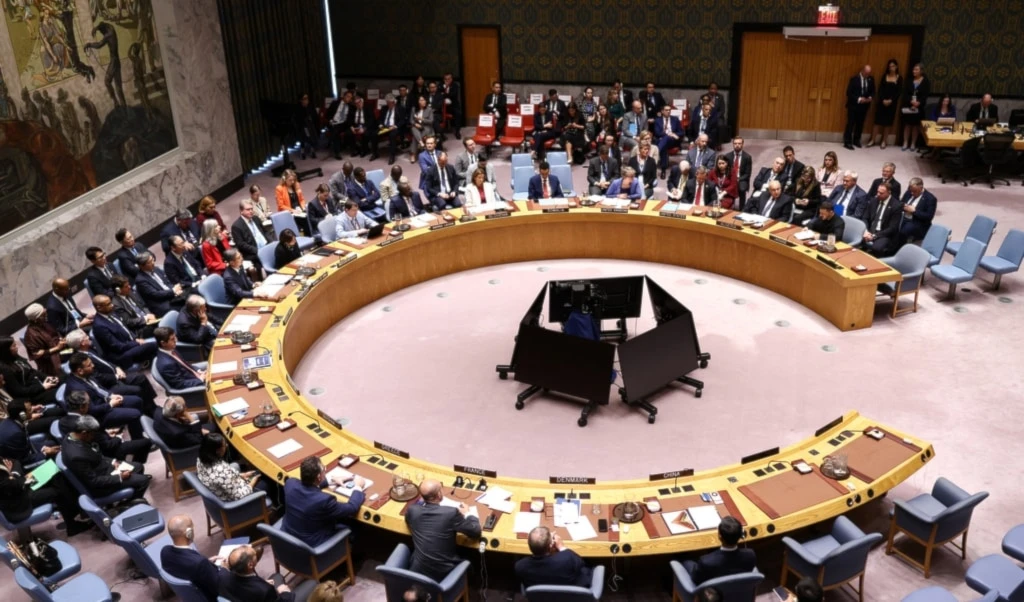From al-Bureij to Jabalia: Israeli massacres in Gaza continue
Families continue to be torn apart and aid seekers gunned down as Israeli strikes turn shelters, streets, and homes across Gaza into scenes of devastation and mourning.
-

A Palestinian boy is checked for signs of malnutrition by a nurse at a medical clinic in Gaza City amid the ongoing Israeli genocide, Wednesday, May 28, 2025 (AP)
At least 41 Palestinians were massacred since dawn in a series of brutal Israeli airstrikes on Gaza, with invading Israeli units launching coordinated assaults across the besieged Strip, according to Al Mayadeen’s correspondent. The attacks mark a continued escalation in the Gaza genocide campaign as "Israel" intensifies its targeting of residential areas and aid routes.
In one of the harrowing massacres on Thursday, "Israel" committed a massacre in al-Bureij, central Gaza, where at least 30 civilians were martyred in a strike on a residential block sheltering forcibly displaced families in the camp’s eastern section. Another strike also targeted the eastern area of the camp shortly afterward, further endangering already vulnerable populations, as per our correspondent.
In the southern Strip, IOF targeted a group of civilians on their way to an aid distribution center located between Khan Younis and Rafah, killing one person and injuring several others. The wounded were transferred to the Nasser Medical Complex for treatment.
Simultaneously, Israeli helicopter gunships opened fire toward the town of al-Qarara, northeast of Khan Younis. In Aabasan Al-Kabira, the body of a martyr was pulled from the rubble of a home destroyed in a separate strike.
Gaza City hit by intense shelling and drone fire
In Gaza City, intense artillery shelling struck eastern neighborhoods, as Israeli quadcopter drones opened fire on Palestinians in al-Shaaf. Several people were reported wounded.
In addition, an Apache helicopter fired on the al-Tuffah and al-Shujaiya neighborhoods. In al-Shujaiya, the bodies of three martyrs, previously killed in an earlier strike, were retrieved from under the rubble, our correspondent reported.
Further north on al-Jalaa Street, six people were martyred and others were wounded when an Israeli strike hit a group of civilians in the area.
In the north of the Gaza Strip, Jabalia al-Balad was once again the target of Israeli shelling, where three civilians were martyred and others were injured after a strike hit a residential building.
Artillery shelling also struck the al-Jarn roundabout, causing multiple injuries and adding to the growing death toll.
Nearly 4,000 killed since March amid intensified Israeli assault
In a related development, hospitals across the Gaza Strip have reported receiving 67 martyrs, including five bodies retrieved from beneath the rubble, and 184 injuries in 24 hours, according to the latest statistical report on casualties from the ongoing Israeli aggression.
Medical authorities noted that these figures exclude data from hospitals in the northern Gaza governorate, due to the severe limitations in accessing the area amid continuous bombardment and road destruction.
Civil defense sources confirmed that a number of victims remain trapped beneath collapsed buildings and on roads, where ambulance and rescue teams are unable to reach them due to the intensity of the occupation’s attacks and the destruction of vital infrastructure.
As of May 29, 2025, the cumulative death toll from the Israeli genocide in Gaza has risen to 54,249, in addition to 123,492 injuries, since October 7, 2023.
This total includes an additional 98 martyrs whose deaths were recently verified and added to the official count by the judicial committee overseeing casualty documentation.
Since March 18, 2025, a period marked by escalated assaults and mass displacement, Gaza has recorded 3,986 martyrs and 11,451 injuries, further straining the Strip’s devastated healthcare system and underscoring the urgent need for humanitarian intervention.
Health officials continue to warn that the true toll is likely far higher, as large areas remain inaccessible and communication with northern medical centers is severely compromised.
UNICEF and UNRWA urge immediate, scaled humanitarian access
The humanitarian situation in the Gaza Strip continues to deteriorate at an alarming rate, with United Nations officials issuing urgent warnings about the devastating impact on children amid growing starvation, dehydration, and malnutrition.
Starvation. Dehydration. Malnutrition.
— UNICEF (@UNICEF) May 27, 2025
The reality for children in Gaza is horrific.
Aid at scale is urgently required in Gaza.
With UNICEF spokesperson @1james_elder. pic.twitter.com/SWhfLHQdYQ
In a post on social media platform X, James Elder, a spokesperson for UNICEF, described the conditions for children in Gaza as “horrific", emphasizing that large-scale aid delivery is urgently required to prevent further loss of life.
“We already have an aid distribution system that is fit for purpose,” said @UNLazzarini to Guardian. “The clock is ticking towards famine, so humanitarian work must be allowed to do its life-saving work now.”
— UNRWA (@UNRWA) May 29, 2025
To prevent the current disaster in #Gaza from spiralling further,… pic.twitter.com/unt1oRRyS6
Echoing the alarm, UNRWA Commissioner-General Philippe Lazzarini told The Guardian that the infrastructure and logistics for delivering aid are already in place, but access must be granted immediately.
“We already have an aid distribution system that is fit for purpose,” Lazzarini stated.
“The clock is ticking towards famine, so humanitarian work must be allowed to do its life-saving work now.”
According to the UN, between 500 to 600 trucks of humanitarian supplies are needed daily to meet the urgent needs of Gaza’s population. However, the occupation’s ongoing blockade and targeting of aid convoys have severely disrupted access, pushing the already dire conditions closer to famine.
Lazzarini underscored that this scale of aid can only be achieved through the United Nations, including the continued operation of UNRWA, which remains a lifeline for millions of Palestinians despite political pressure and funding cuts from Western states.
Humanitarian agencies have reiterated the need for rapid, reliable, safe, and sustained access to Gaza, urging international actors to facilitate the uninterrupted flow of food, water, and medical supplies.
The warnings come as the health system in Gaza has all but collapsed, and entire communities are left without access to clean water or basic nutrition. The United Nations has consistently emphasized that without immediate action, the current humanitarian disaster risks spiraling into full-scale famine.

 5 Min Read
5 Min Read










